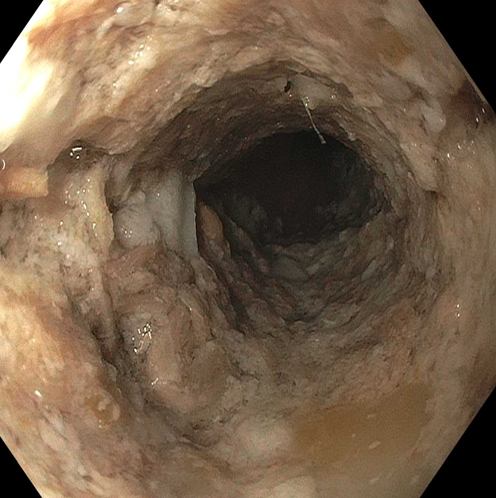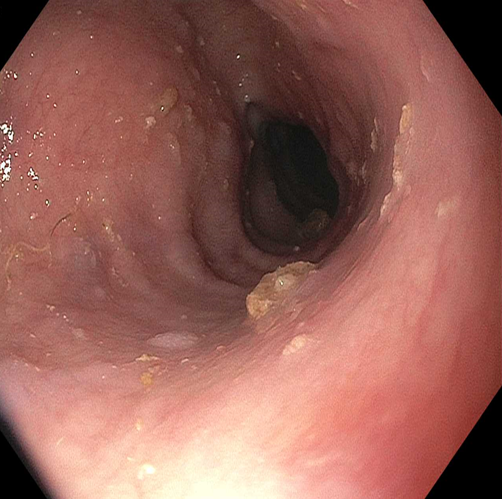Monday Poster Session
Category: Esophagus
P2867 - Cola vs Food Impaction: A Case of Dysphagia Resolved
Monday, October 27, 2025
10:30 AM - 4:00 PM PDT
Location: Exhibit Hall

Nicole Ng, MD (she/her/hers)
NewYork-Presbyterian Hospital/Weill Cornell Medical Center
New York, NY
Presenting Author(s)
Nicole Ng, MD, Chimsom Orakwue, MD, Danielle Morelli, MD, David Wan, MD
NewYork-Presbyterian Hospital/Weill Cornell Medical Center, New York, NY
Introduction: Food impaction is when food is lodged and potentially obstructs the esophagus. The utility of cola for food impaction has been controversial. Here we describe a case of food impaction that was successfully resolved with use of Pepsi® during endoscopy.
Case Description/
Methods: A 70-year-old man with a history of achalasia status post laparoscopic myotomy with Toupet procedure presented with acute-on-chronic dysphagia. The night prior to presentation, he started regurgitating pills and food, associated with mild chest pressure. He was using seltzers more frequently to assist with food intake.
His gastroenterologist advised him to present to the hospital. He was hemodynamically stable upon arrival. Chest x-ray showed a small hiatal hernia versus dilated distal esophagus. Endoscopy showed a tortuous middle and lower esophagus with copious amounts of solid/semi-solid food and a medication pill in the upper third. Most of the food was caked in the lower third at the three o'clock position, just proximal to the gastroesophageal junction (GEJ). The GEJ orifice was not narrowed, allowing the scope to pass through without resistance. Attempts to push food into the stomach, and the later use of an ultra-thin scope attached to larger suction tubing were unsuccessful. Next, 200 milliliters of Pepsi® was administered through a syringe, which appeared to help dissolve the nonsolid food debris. A Roth net was then used to extract the impacted food from the mouth. The remainder of the stomach and duodenum were normal. The patient improved on a full liquid diet post-procedure and was discharged home with close outpatient follow up.
Discussion: Food impaction often occurs with esophageal strictures or motility disorders. In this case, the patient’s achalasia and tortuous esophagus likely increased his risk of food impaction. While endoscopic removal is standard (and surgical removal in severe cases), medical management has not been well delineated. The therapeutic role of carbonated beverages has been debated. The effervescence from carbon dioxide in cola is theorized to not only distend the esophagus, but also decrease the lower esophageal sphincter pressure to facilitate clearance. While some studies showed no meaningful improvement with oral cola consumption in patients with food bolus impaction, several case reports have demonstrated efficacy with co-administration of cola and pancrelipase. Cola can be considered as an option if initial endoscopic techniques are ineffective.

Figure: Pre-Intervention, Mid Esophagus

Figure: Post-Intervention with Pepsi®, Upper-Mid Esophagus
Disclosures:
Nicole Ng indicated no relevant financial relationships.
Chimsom Orakwue indicated no relevant financial relationships.
Danielle Morelli indicated no relevant financial relationships.
David Wan: Medtronic – Data Monitoring Committee.
Nicole Ng, MD, Chimsom Orakwue, MD, Danielle Morelli, MD, David Wan, MD. P2867 - Cola vs Food Impaction: A Case of Dysphagia Resolved, ACG 2025 Annual Scientific Meeting Abstracts. Phoenix, AZ: American College of Gastroenterology.
NewYork-Presbyterian Hospital/Weill Cornell Medical Center, New York, NY
Introduction: Food impaction is when food is lodged and potentially obstructs the esophagus. The utility of cola for food impaction has been controversial. Here we describe a case of food impaction that was successfully resolved with use of Pepsi® during endoscopy.
Case Description/
Methods: A 70-year-old man with a history of achalasia status post laparoscopic myotomy with Toupet procedure presented with acute-on-chronic dysphagia. The night prior to presentation, he started regurgitating pills and food, associated with mild chest pressure. He was using seltzers more frequently to assist with food intake.
His gastroenterologist advised him to present to the hospital. He was hemodynamically stable upon arrival. Chest x-ray showed a small hiatal hernia versus dilated distal esophagus. Endoscopy showed a tortuous middle and lower esophagus with copious amounts of solid/semi-solid food and a medication pill in the upper third. Most of the food was caked in the lower third at the three o'clock position, just proximal to the gastroesophageal junction (GEJ). The GEJ orifice was not narrowed, allowing the scope to pass through without resistance. Attempts to push food into the stomach, and the later use of an ultra-thin scope attached to larger suction tubing were unsuccessful. Next, 200 milliliters of Pepsi® was administered through a syringe, which appeared to help dissolve the nonsolid food debris. A Roth net was then used to extract the impacted food from the mouth. The remainder of the stomach and duodenum were normal. The patient improved on a full liquid diet post-procedure and was discharged home with close outpatient follow up.
Discussion: Food impaction often occurs with esophageal strictures or motility disorders. In this case, the patient’s achalasia and tortuous esophagus likely increased his risk of food impaction. While endoscopic removal is standard (and surgical removal in severe cases), medical management has not been well delineated. The therapeutic role of carbonated beverages has been debated. The effervescence from carbon dioxide in cola is theorized to not only distend the esophagus, but also decrease the lower esophageal sphincter pressure to facilitate clearance. While some studies showed no meaningful improvement with oral cola consumption in patients with food bolus impaction, several case reports have demonstrated efficacy with co-administration of cola and pancrelipase. Cola can be considered as an option if initial endoscopic techniques are ineffective.

Figure: Pre-Intervention, Mid Esophagus

Figure: Post-Intervention with Pepsi®, Upper-Mid Esophagus
Disclosures:
Nicole Ng indicated no relevant financial relationships.
Chimsom Orakwue indicated no relevant financial relationships.
Danielle Morelli indicated no relevant financial relationships.
David Wan: Medtronic – Data Monitoring Committee.
Nicole Ng, MD, Chimsom Orakwue, MD, Danielle Morelli, MD, David Wan, MD. P2867 - Cola vs Food Impaction: A Case of Dysphagia Resolved, ACG 2025 Annual Scientific Meeting Abstracts. Phoenix, AZ: American College of Gastroenterology.
